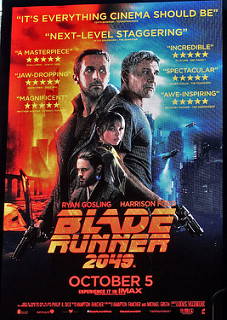By ABBY WEBSTER, staff writer
“To be born is to have a soul.” – “Blade Runner 2049”
A baby’s sock. A wooden toy horse. An artificial memory of children huddled around a birthday cake.
Motifs of birth pervade “Blade Runner 2049,” standing in stark contrast to the ubiquitous theme of death in “Blade Runner.” The original cult classic is the quietus of a cycle and the sequel is a renaissance, recognizing the inevitable that must come first: life.
It is in this thematic difference that “Blade Runner 2049” distinguishes itself from the current Hollywood culture of cash grab sequels, which siphon popularity from a piece of pop culture by hitting right in the nostalgia sweet spot. This film isn’t an appendage, it’s an extension.
K, played by Ryan Gosling, is a blade runner whose job is to hunt down and ‘retire’ replicants, or androids that are manufactured to look and act uncannily like humans. Unlike Deckard, played by Harrison Ford, there is no ambiguity that he is also a replicant himself, and this fundamentally shifts the perspective that was established in the first film.
When he makes the discovery that two replicants have successfully procreated, something previously thought to be impossible, K is forced to grapple with his identity and the implication that it could have.
Air full of particulate matter, the Los Angeles of the future is trapped in a continual dusk. Radiant neon street signs of the original film give way to luminous holograms lighting up an otherwise barren sky, and beyond the city limits, desolate structures are thoroughly shrouded in a tangerine dust.
The city is unrecognizable to the one we know, but it’s unmistakably the world from “Blade Runner.” The backbone of science fiction and of noir is their worldbuilding, and as it derives from both genres, “Blade Runner 2049” has it in spades.
Just as replicants of the series can be more humane than humans, artifice can tell a more effective story than the gritty “realism” of countless Hollywood dystopias. A monotone palette of greys and blues acts as a visual shorthand for a deteriorating world, but this practice rarely makes for a composition of equal beauty to any one of the shots throughout “Blade Runner 2049.”
The contrasting look and tone of the film are only fitting of its universe; technological advancement masks societal decay with its colorful wastelands, the hues oozing off the screen. Who knew smog could be so appealing?
Any flaws the film has are minor quibbles, but they are enough to detract from the technical perfection. Though the “Blade Runner” franchise delves into the complexities of humanity, the relationships always come across as shallow.
While the status of the male heroes is unclear, forcing us to empathize with them whether they are replicants or not, the female love interests are always decidedly inhuman: in “Blade Runner 2049,” Joi is an A.I. programmed to meet the buyer’s needs.
Her lack of autonomy does nothing to evolve the themes of existence—she’ll live and die by K’s side—nor does it hardly make K a more sympathetic character. One scene between them acts as more of a vehicle to explore the technology of the future and boast the special effects than to advance the narrative. A long runtime isn’t always a negative, but the romance taking up space in the film’s 163 minutes unnecessarily pads what is otherwise a masterpiece.
“You’ve never seen a miracle,” whispers an older model replicant to ‘K’ from the shadows; but now I can say that I have, and it came in the form of a nearly three-hour visual odyssey.
4.5/5
Photo labeled for reuse
